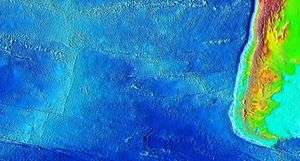Traiguén Formation
| Traiguén Formation Stratigraphic range: Early Miocene | |
|---|---|
| Type | Geological formation |
| Lithology | |
| Primary | Tuff, basaltic pillow lava, breccia, sandstone, shale |
| Location | |
| Region | Aysén Region |
| Country | Chile |
| Type section | |
| Named for | Traiguén Island |
| Named by | Espinoza and Fuenzalida (1971) |
Traiguén Formation (Spanish: Formación Triaguén) is a volcano-sedimentary formation of Miocene age located in the Aysén Region of western Patagonia, southern Chile.
Geology
The volcanic and sedimentary rocks were deposited in a marine environment. Neither the base nor the top of the formation is known. Copious dykes of basic composition and aphanitic texture intrude the formation.
At some locations Miocene plutons of the North Patagonian Batholith intrude the Traiguén Formation. The intruded plutons are of varied composition including gabbro and granodiorite.[1]
See also
- Geology of Aysén Region
- Stratigraphy of Chile
References
- ↑ Encinas, Alfonso; Folguera, Andrés; Oliveros, Verónica; De Girolamo Del Mauro, Lizet; Tapia, Francisco; Riffo, Ricardo; Hervé, Francisco; Finger, Kenneth L.; Valencia, Víctor A.; Gianni, Guido; Álvarez, Orlando (2016). "Late Oligocene–early Miocene submarine volcanism and deep-marine sedimentation in an extensional basin of southern Chile: Implications for the tectonic development of the North Patagonian Andes". Geological Society of America Bulletin. 128 (5–6): 807–823.
This article is issued from Wikipedia - version of the 9/7/2016. The text is available under the Creative Commons Attribution/Share Alike but additional terms may apply for the media files.
